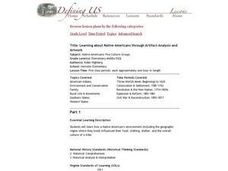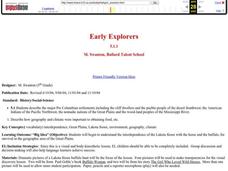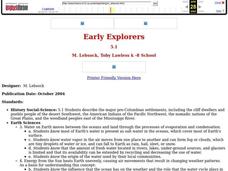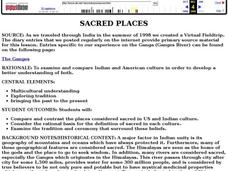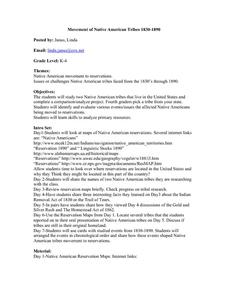Curated OER
Enduring Cultures
Students research the art, dance or a game from the Pacific Northwest Coast Aborigines. In this Canadian Cultures lesson, students view a PowerPoint about the Inuits. Students choose a game , type of artwork or dance to...
Curated OER
Learning about Native Americans through Artifact Analysis and Artwork
Sixth graders assess how a Native American's environment and the geographic region where they lived influenced their food, clothing, shelter and the overall culture of a tribe. They study the impact of conservation, family, rural life,...
Curated OER
On Being Hindu...and American
Students explore the concept of acculturation. In this cultural diversity lesson, students examine how second generation Hindu-Americans have adjusted to life in the United States.
Curated OER
Early Explorers
Fifth graders examine how the environment and climate affected Pre-Colombian settlements. In this civilization lesson, 5th graders view pictures of different Native American tribes in different places and discuss how different groups...
Alabama Learning Exchange
Exploring Explorers
Learners gather information about a 15th to 17th century explorer and prepare a script in talk show format about the individual. Finally, students make a video following the script and present it to the class.
Curated OER
The Lewis and Clark Expedition
Young scholars explore the challenges of the Lewis and Clark Expedition through a physical education simulation. In this cross-curriculum physical education lesson, students work in groups of three to log 8000 steps, stopping to...
Curated OER
Great Basin Tribes- Use of Land for Sustenance
Learners explore four Native American tribes from Nevada. In this Native American history lesson, students identify and generate important corresponding attributes of the Southern Paiute, Northern Paiute, Washoe, and Western Shoshone...
Curated OER
Arizona
Students engage in a series of lessons about Arizona. They perform experiments and participate in activities across the curriculum. They perform research on websites imbedded in this plan to complete a variety of tasks.
Curated OER
Coral Reef Conservation
Students conduct discussions on current threats to coral reefs around the world and write letters to conservation organizations urging support for coral reef protection.
Curated OER
Ofelia Romero The Maya Culture and Civilization
Fifth graders investigate the Mayan culture, number system, alphabet, hieroglyphics, history, civilization, artistry, and sports in this series of lessons.
Curated OER
The Heart of Human Experience: Cultura Azteca
First graders explore Aztec culture to gain understanding of relationship between music, recreation, and culture. Seven lessons on one page.
Curated OER
Island of the Blue Dolphins Jigsaw
Fourth graders research three topics from the book, either Village Life, Sea Life, or San Nicholas Island. They research independently and meet in a jigsaw format to share what they learned. As group they create a poster for class...
Curated OER
Early Explorers
Fifth graders study early explorers. In this World history lesson plan, 5th graders draw an outline of a map labeling each part, build geographical features out of dough, and paint each of the land and water features.
Curated OER
Economics Concepts
Learners relate economics and government policies. In this lesson, students explore the relationship between economics and government policies. They understand how the economy works and can make better decisions as it relates to the future.
Curated OER
Louisiana Purchase
Students explore U.S. territorial expansion. For this Louisiana Purchase lesson, students investigate how the purchase was funded and determine how diplomatic actions were part of the land transfer. Students analyze several primary...
Curated OER
Sacred Places
Learners examine places considered sacred in both India and the U.S. They read and discuss a website on the Ganges River, discuss places considered sacred in the U.S., and write an essay comparing/contrasting personal sacred places and...
Curated OER
Oceans of the World
Students compare and contrast information about oceans. They locate the oceans on a globe, and in small groups conduct Internet research on the oceans, identifying the similarities and differences and writing a report.
Curated OER
Persistent Paths: Trails, Tracks and Turnpikes Across the Alleghenies
High schoolers study maps to determine barriers associated with the Pennsylvania mountains and the Native Americans. In this investigative lesson plan learners study the routes used by Native Americans, explain physical features of...
Curated OER
Movement of Native American Tribes 1830-1890
Students examine the movement of Native American tribes during the mid 1800's. In this American History lesson, students study two Native American tribes that live in the United States and complete a comparison/analyze project. Students...
Curated OER
Native Americans During the 19th and 20th Centuries
Students explore major events in Native American history in the nineteenth and twentieth centuries. In this American history lesson, students listen to lectures, examine photographs, and analyze music regarding Native American history...
Curated OER
Encounters – Native Americans and Euro Americans (1850-1870)
Students consider the plight of Native Americans. In this Oregon history lesson, students research Internet and print sources regarding land conflicts between the whites and Native Americans. Students discuss resettlement and...
Alabama Learning Exchange
Learning About Colonial Life
High schoolers use predictions to explore the lifestyle of American colonists. They draw conclusions about the culture of colonial America based on items used in daily life.
Curated OER
How Can We Locate Specific Places On Earth?
Second graders discover how to use longitude and latitude to locate specific sites on Earth. They compare old and new ways of locating specific places, and discover how latitude and longitude coordinates are used to locate places on Earth.
Curated OER
The Tadpole and the Frog
First graders examine the life cycle of the frog, and research frogs of the Nez Perce reservation and their requirements for survival. They observe the development of frog eggs and record their observations in science journals.

